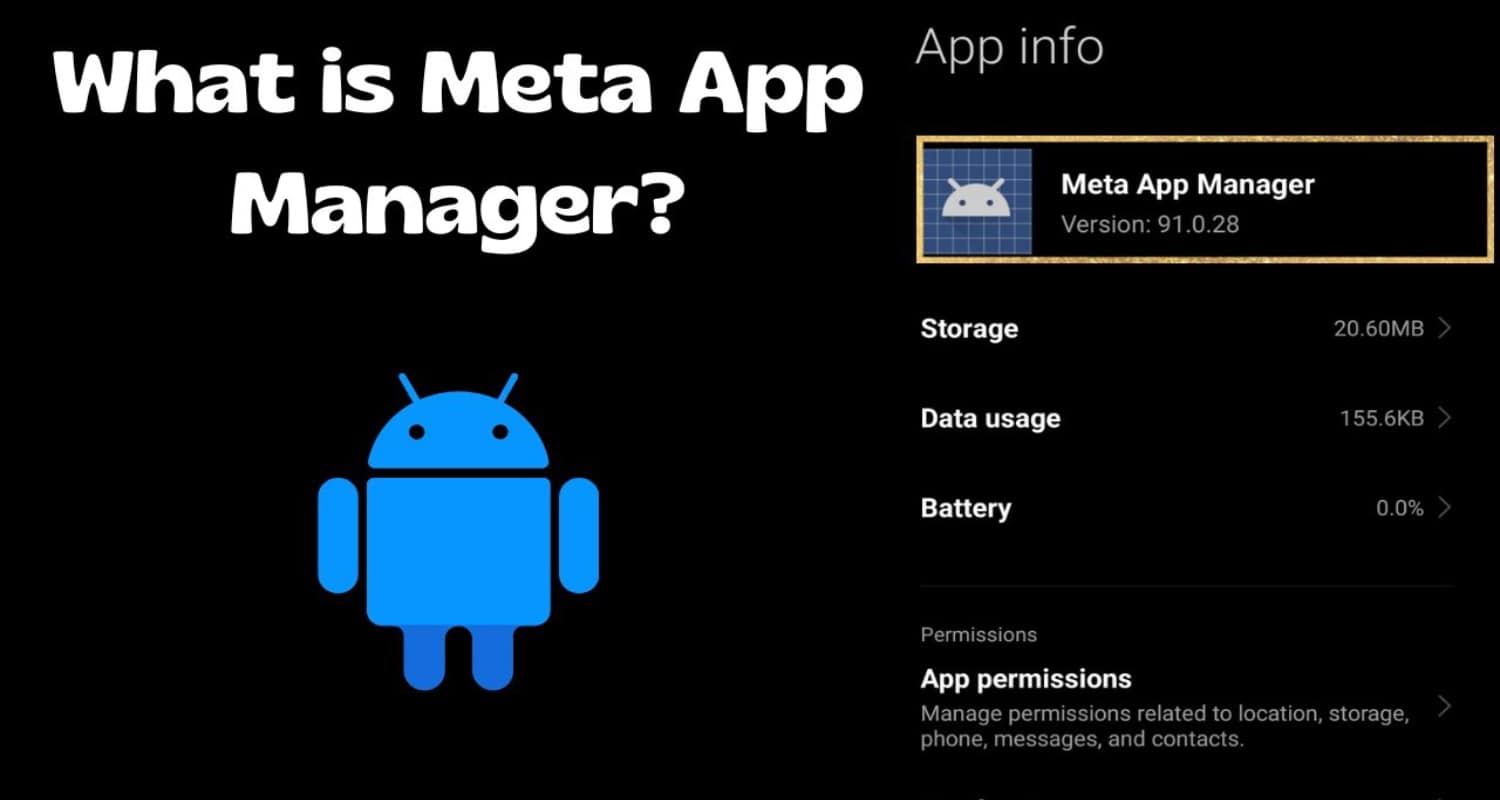
Have you ever stumbled upon ‘Meta App Manager’ on your Android device and wondered what mysterious role it plays in the digital realm of your smartphone? This enigmatic component, often lurking unnoticed, is actually a pivotal player in your daily digital experience. Imagine this: you’re navigating through your favorite apps, and suddenly, they start lagging or draining your battery at an alarming rate. Frustrating, isn’t it? This is where the Meta App Manager steps in, a silent guardian and optimizer of your app universe.
What is Meta App Manager on Android? Meta App Manager on Android is a system tool that manages and optimizes Meta-owned applications like Facebook, WhatsApp, and Instagram. It oversees app updates, data syncing, and ensures seamless app functionality, balancing performance with user privacy and data usage on Android devices.
So, what’s the solution? Understanding is the first step. By demystifying this tool, you can regain control over your digital life, balancing convenience with informed choices. Let’s dive into the world of Meta App Manager and unravel its mysteries.
See Also: How To Change Font Color On Android?
Understanding Meta App Manager: Features and Functionalities
While exploring the functionalities of Meta App Manager, it’s also worth mentioning the ‘Meta app installer’ on Android. This component works in tandem with the App Manager, focusing on the installation and initial setup of Meta-owned apps. It ensures that apps like Facebook and Instagram are not only updated but also correctly installed and configured on your device. For more insights on optimizing your Android device’s performance, explore the guide on how to stop apps running in background on Android programmatically.
The Essence of Meta App Manager
Let’s start with the basics: What exactly is Meta App Manager? Think of it as the behind-the-scenes maestro of your Android device, orchestrating the smooth operation of Meta-owned apps like Facebook, Instagram, and WhatsApp. It’s this nifty tool that ensures your favorite social apps are always up-to-date, running smoothly, and in sync with your digital lifestyle.
A Symphony of Updates
One of the key features of Meta App Manager is its update management. It’s like having a personal assistant who diligently keeps your apps in their prime. You know those moments when you open an app and find a new, exciting feature or an annoying bug that’s been fixed? You can thank Meta App Manager for that. It silently updates your apps, ensuring you’re always equipped with the latest and greatest versions.
Data Usage and Performance: A Balancing Act
But it’s not just about updates. Meta App Manager is also a guardian of your device’s resources. It’s constantly juggling data usage and performance optimization. This means it’s working hard to ensure that your apps don’t drain your data plan or hog your device’s memory. It’s all about delivering a seamless experience without the side effects of slowed-down performance or unexpected data usage spikes.
The Puppeteer of Meta Apps
Now, let’s talk about its role in managing Meta apps. Meta App Manager is like the puppeteer, pulling the strings to ensure that your experience across Facebook, Instagram, and WhatsApp is cohesive and uninterrupted. It synchronizes your data across these platforms, so your digital persona is consistent, whether you’re sharing a story on Instagram or messaging friends on WhatsApp.
The Impact of Meta App Manager on Device Performance
In discussing the impact on device performance, it’s crucial to consider the ‘Meta services app on Android’. This integral part of the Meta ecosystem works closely with the App Manager, influencing how your device handles data and privacy. Understanding the role of Meta services is key to comprehending the full scope of Meta App Manager’s influence on your Android device. For users experiencing issues with app performance, the article on not enough memory to open this page might offer helpful solutions.
Navigating the Performance Seas
When it comes to the impact of Meta App Manager on your Android device, it’s a bit like navigating a sea with varying currents. On one hand, it’s designed to streamline and enhance your app experience. But on the other, it can have some unintended consequences on your device’s performance.
A Double-Edged Sword for Device Resources
Firstly, let’s talk about the resource usage. Meta App Manager, in its quest to keep your apps updated and in sync, can be a bit of a resource hog. It needs to use some of your device’s memory and processing power to do its job. This means, especially on older or less powerful devices, you might notice your phone becoming a bit sluggish or the battery draining faster than usual. It’s the trade-off for having those apps running smoothly and being up-to-date.
Privacy Concerns: The Invisible Cost?
Then there’s the big elephant in the room: privacy. In today’s digital age, data is king, and how it’s handled is a concern for many. Meta App Manager works by syncing data across Meta apps, which raises questions about how much data it’s accessing and what it’s doing with it. While it’s not inherently malicious, the idea of an app having such deep access to your personal data can be unsettling for some. It’s a bit like having a helpful but overly inquisitive neighbor; sure, they’re great at keeping things in order, but you might wonder just how much they know about your comings and goings.
Balancing Act: Performance vs. Privacy
So, what’s the verdict? Meta App Manager is a bit of a balancing act. It’s there to make your life easier by managing your apps, but it also comes with its own set of implications for device performance and privacy. Understanding these trade-offs is key to managing your device in a way that aligns with your priorities, whether that’s optimal performance, data conservation, or safeguarding your digital footprint.
Common Issues and Troubleshooting with Meta App Manager
When addressing common issues, it’s important to understand ‘what is Meta services on Android’. These services, managed by the Meta App Manager, can sometimes be the root cause of issues like app crashes or synchronization problems. Recognizing their function helps in effectively troubleshooting and resolving such issues. If you’re facing difficulties with Meta apps on your device, consider reading about how to reinstall Android for potential solutions.
Decoding the Glitches
Meta App Manager, while a handy tool, isn’t without its quirks and conundrums. Users often encounter a few common issues that can range from mildly annoying to downright disruptive. 
The Usual Suspects: Lag and Battery Drain
A frequent complaint is the dreaded lag or slowdown in device performance. This often happens when Meta App Manager is in the midst of updating apps or syncing data. It’s like your phone is trying to run a marathon with a heavy backpack. Another issue? Battery drain. Yes, keeping your apps in tip-top shape can be a bit of a power guzzler.
Troubleshooting Tips: Regain Your Speed
So, what can you do? First, check if Meta App Manager is the actual culprit. Dive into your device settings and peek at the battery and performance sections. If Meta App Manager is hogging resources, consider clearing its cache. It’s like giving your device a mini-break, a chance to catch its breath.
Optimizing App Performance: A Proactive Approach
Another tip is to be proactive with your app management. Regularly update your apps manually, so Meta App Manager doesn’t have to do heavy lifting in the background. Also, consider disabling automatic updates during times when you need peak performance from your device.
The Final Word: Stay Informed, Stay in Control
In summary, while Meta App Manager is designed to make your life easier, staying informed and proactive about its quirks is key. By understanding common issues and knowing how to troubleshoot them, you can keep your device running smoothly, ensuring that Meta App Manager is a help, not a hindrance.
Step-by-Step Guide: How to Delete or Disable Meta App Manager
As you consider disabling or deleting Meta App Manager, it’s also helpful to know ‘what is Meta services on my Android’. These services, integral to the operation of Meta apps, will be affected by any changes you make to the App Manager. Being aware of this helps you anticipate and manage the changes in app behavior post-deletion or disabling. For more comprehensive instructions on managing your Android device, check out the guide on how to use Samsung Android dialer.
Embarking on the Journey of Deletion
Sometimes, you might decide that the Meta App Manager is more trouble than it’s worth. Whether it’s for privacy concerns, performance issues, or just to declutter your device, removing or disabling it can feel like a breath of fresh air. Here’s a step-by-step guide to help you navigate this process.
Step 1: The Preparation
Before you dive in, it’s crucial to back up any important data from your Meta apps like Facebook, Instagram, and WhatsApp. Disabling or deleting Meta App Manager could affect how these apps function, and you don’t want to lose any precious memories or contacts.
Step 2: Navigating to the Core
- Open your Android device’s ‘Settings’.
- Scroll down and tap on ‘Apps’ or ‘Application Manager’ (the name varies depending on your device).
Step 3: Locating the Meta App Manager
- In the list of apps, find ‘Meta App Manager’. It might be listed under ‘System Apps’, so keep an eye out.
Step 4: The Disabling/Deletion Process
- Once you’ve opened the Meta App Manager settings, you’ll have a couple of options. If you see ‘Uninstall’, you can remove the app completely. If not, look for the ‘Disable’ option. This will stop the app from running and remove it from your app drawer, but it won’t delete it from your device.
Step 5: Clearing the Cache and Data
- Before you hit ‘Uninstall’ or ‘Disable’, it’s a good idea to clear the app’s cache and data. This will remove any temporary files and settings associated with the app. Tap on ‘Storage’, then ‘Clear Cache’ and ‘Clear Data’.
Step 6: The Final Step
- Now, you can proceed with ‘Uninstall’ or ‘Disable’. Confirm your choice, and voilà, you’ve successfully removed or disabled Meta App Manager.
Post-Deletion: What to Expect
After deletion, your device might feel snappier, and you might notice improved battery life. However, be prepared for potential hiccups with Meta apps. They might not update automatically or sync data as seamlessly as before. If you encounter any issues, you can always reinstall or re-enable Meta App Manager.
Remember, managing your device is all about making choices that align with your needs and preferences. This guide is just a starting point to help you take control of your digital experience.
FAQs
What is Meta App Manager on Android?
Meta App Manager is a system tool on Android devices that manages updates and functionality for Meta-owned apps like Facebook, Instagram, and WhatsApp. It ensures these apps run smoothly and are up-to-date.
Can I uninstall Meta App Manager from my Android device?
Uninstalling Meta App Manager can be challenging as it's often integrated into the system. However, you can disable it from the app settings, which stops it from running and removes it from the app drawer.
Does Meta App Manager affect my device's performance?
Meta App Manager can impact device performance, potentially causing lag or increased battery drain due to its background activities like updating and syncing apps.
Is Meta App Manager a privacy concern?
While Meta App Manager itself is not malicious, it does manage data syncing for Meta apps, which raises concerns about the extent of data access and usage, making privacy a consideration for users.
What happens if I disable Meta App Manager?
Disabling Meta App Manager might lead to issues with automatic updates and data synchronization in Meta apps. You might need to manually update apps like Facebook, Instagram, and WhatsApp.
Conclusion: Balancing Convenience and Control
In the digital dance of our daily lives, understanding tools like Meta App Manager is more than just tech-savvy—it’s about striking a balance between convenience and control. This app, a silent conductor behind the scenes, plays a significant role in how we interact with our favorite social platforms. However, with this convenience comes the need for awareness about its impact on device performance and privacy.
Making informed decisions about Meta App Manager isn’t just about optimizing your device; it’s a step towards digital well-being. Whether you choose to keep it, disable it, or remove it entirely, the key is understanding its role and implications. By doing so, you’re not just a passive user, but an active participant in your digital world, ensuring that your tech serves you, not the other way around.




